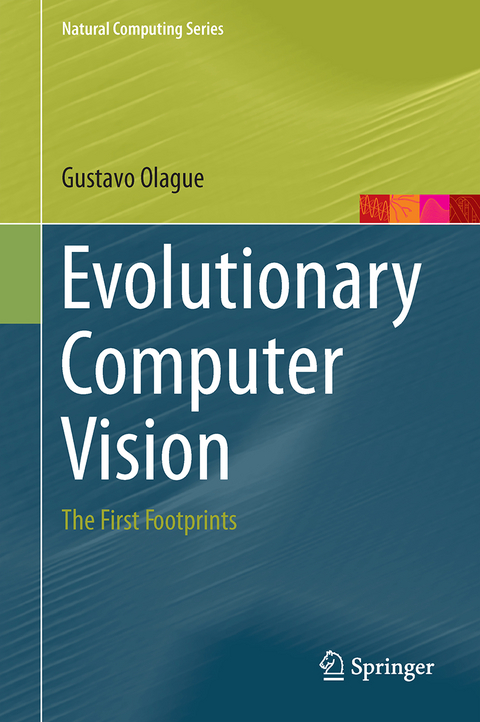
Evolutionary Computer Vision
Springer Berlin (Verlag)
978-3-662-43692-9 (ISBN)
This book explains the theory and application of evolutionary computer vision, a new paradigm where challenging vision problems can be approached using the techniques of evolutionary computing. This methodology achieves excellent results for defining fitness functions and representations for problems by merging evolutionary computation with mathematical optimization to produce automatic creation of emerging visual behaviors.
In the first part of the book the author surveys the literature in concise form, defines the relevant terminology, and offers historical and philosophical motivations for the key research problems in the field. For researchers from the computer vision community, he offers a simple introduction to the evolutionary computing paradigm. The second part of the book focuses on implementing evolutionary algorithms that solve given problems using working programs in the major fields of low-, intermediate- and high-level computer vision.
This book will be ofvalue to researchers, engineers, and students in the fields of computer vision, evolutionary computing, robotics, biologically inspired mechatronics, electronics engineering, control, and artificial intelligence.
Gustavo Olague received his Ph.D. in Computer Vision, Graphics and Robotics from INPG (Institut Polytechnique de Grenoble) and INRIA (Institut National de Recherche en Informatique et Automatique) in France. He is a Professor in the Dept. of Computer Science at CICESE (Centro de Investigación Científica y de Educación Superior de Ensenada) in Mexico, and the Director of its EvoVisión Research Team. He is also an Adjoint Professor of Engineering at UACH (Universidad Autonóma de Chihuahua). He has authored over 100 conference proceedings papers and journal articles, he coedited two special issues in Pattern Recognition Letters and Evolutionary Computation, and he served as cochair of the Real-World Applications track at the main international evolutionary computing conference, GECCO (ACM SIGEVO Genetic and Evolutionary Computation Conference). Prof. Olague has received numerous distinctions, among them the Talbert Abrams Award presented by the American Society for Photogrammetry and Remote Sensing (ASPRS) for authorship and recording of current and historical engineering and scientific developments in photogrammetry; Best Paper awards at major conferences such as GECCO, EvoIASP (European Workshop on Evolutionary Computation in Image Analysis, Signal Processing and Pattern Recognition) and EvoHOT (European Workshop on Evolutionary Hardware Optimization); and twice the Bronze Medal at the Humies (GECCO award for Human-Competitive results produced by genetic and evolutionary computation). His main research interests are evolutionary computing and computer vision.
Introduction.- Vision and Evolution: The State of the Art.- Evolutionary Computing.- Accurate Modeling of Image Features Using Evolutionary Computing.- Evolutionary Synthesis of Interest Point Detectors Through Genetic Programming.- The Honeybee Search Algorithm.- Multiobjective Sensor Planning for Accurate Reconstruction.- Evolutionary Visual Learning with Linear Genetic Programming.- Evolutionary Synthesis of Feature Descriptor Operators with Genetic Programming.- Summary and Conclusions.- App. A, Camera Calibration and Stereoscopic Vision.- Glossary.- Index.
"Olague's book aims to lay the foundations of this interdisciplinary research topic, concentrating particularly on goal-driven vision. ... This book is very pleasant to read, clear and well explained. ... Dr. Olague dots the text with original viewpoints, historical perspectives, and philosophical arguments. ... this excellent book is suitable for a large audience: beginners will find all the important features to start with, while specialists will find food for thought." (Evelyne Lutton, Genetic Programming and Evolvable Machines, 2017)
| Erscheint lt. Verlag | 7.10.2016 |
|---|---|
| Reihe/Serie | Natural Computing Series |
| Zusatzinfo | XXII, 411 p. 155 illus., 103 illus. in color. |
| Verlagsort | Berlin |
| Sprache | englisch |
| Maße | 155 x 235 mm |
| Themenwelt | Informatik ► Grafik / Design ► Digitale Bildverarbeitung |
| Informatik ► Theorie / Studium ► Künstliche Intelligenz / Robotik | |
| Naturwissenschaften ► Biologie ► Evolution | |
| Technik | |
| Schlagworte | Artificial Intelligence • artificial vision • computer vision • Darwinian Evolution • Evolutionary Computing (EC) • Evolutionary Synthesis • feature extraction • genetic programming • Machine vision • Optimization • Sensor Planning • Stereoscopic Vision • visual learning |
| ISBN-10 | 3-662-43692-2 / 3662436922 |
| ISBN-13 | 978-3-662-43692-9 / 9783662436929 |
| Zustand | Neuware |
| Haben Sie eine Frage zum Produkt? |
aus dem Bereich


